Comprehensive Financial Report: Microsoft WACC and Capital Structure
VerifiedAdded on 2022/06/22
|14
|2726
|74
Report
AI Summary
This report provides a comprehensive financial analysis of Microsoft, examining its history, weighted average cost of capital (WACC), market value of equity and debt, cost of equity, cost of debt, and gearing ratio. The analysis includes detailed calculations for each component, such as the cost of equity using the Capital Asset Pricing Model (CAPM) and the cost of debt based on interest expense. The report also delves into the company's capital structure, evaluating its leverage and debt ratios. The findings reveal a WACC of 5.993% and a gearing ratio of 1.152, leading to recommendations for optimizing the company's capital structure to enhance investor value by boosting equity and reducing debt. The report suggests increasing equity by 20,000 million USD to improve the financial position of the company.
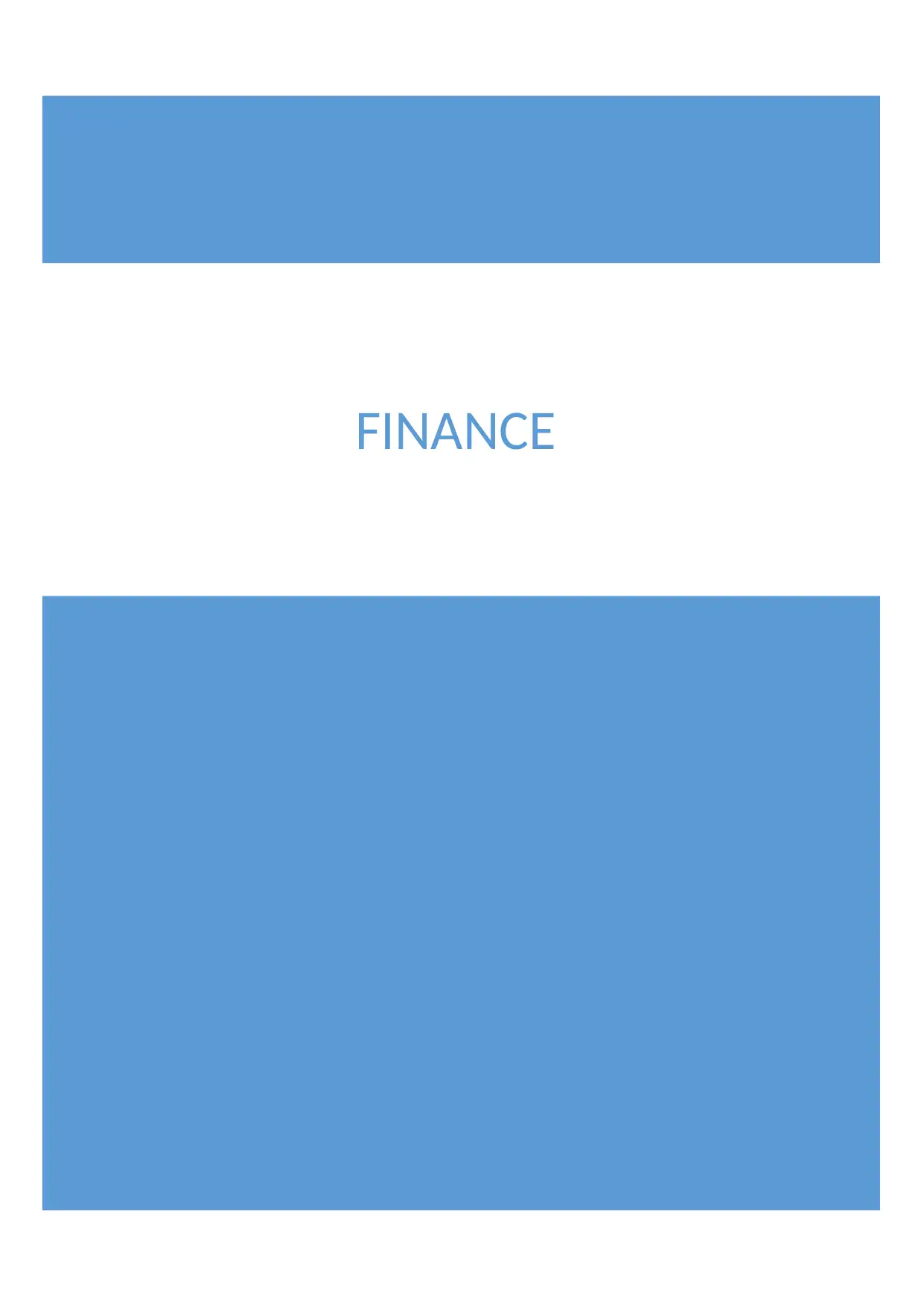
FINANCE
Paraphrase This Document
Need a fresh take? Get an instant paraphrase of this document with our AI Paraphraser
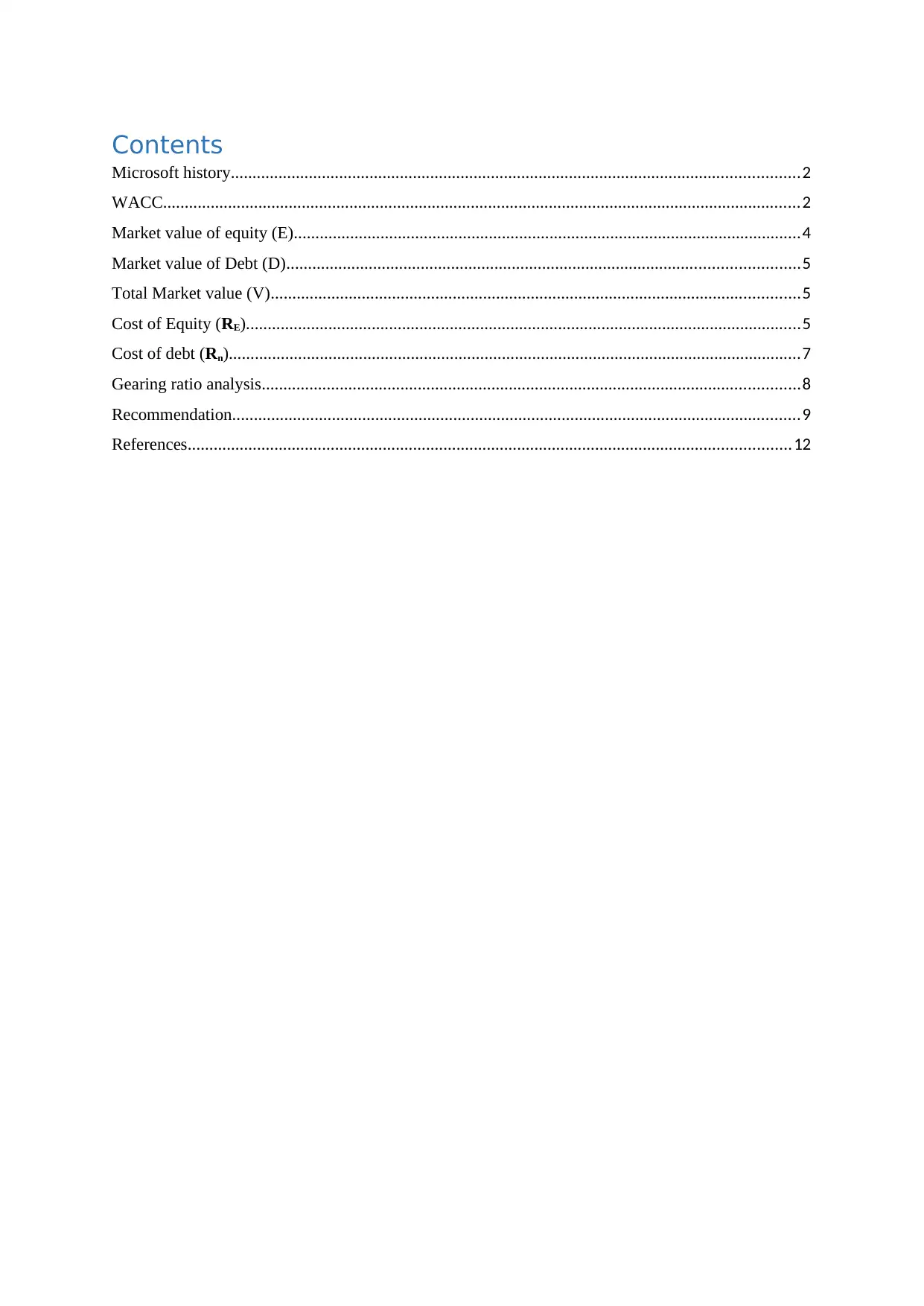
Contents
Microsoft history...................................................................................................................................2
WACC...................................................................................................................................................2
Market value of equity (E).....................................................................................................................4
Market value of Debt (D)......................................................................................................................5
Total Market value (V)..........................................................................................................................5
Cost of Equity (RE)................................................................................................................................5
Cost of debt (Rn)....................................................................................................................................7
Gearing ratio analysis............................................................................................................................8
Recommendation...................................................................................................................................9
References...........................................................................................................................................12
Microsoft history...................................................................................................................................2
WACC...................................................................................................................................................2
Market value of equity (E).....................................................................................................................4
Market value of Debt (D)......................................................................................................................5
Total Market value (V)..........................................................................................................................5
Cost of Equity (RE)................................................................................................................................5
Cost of debt (Rn)....................................................................................................................................7
Gearing ratio analysis............................................................................................................................8
Recommendation...................................................................................................................................9
References...........................................................................................................................................12
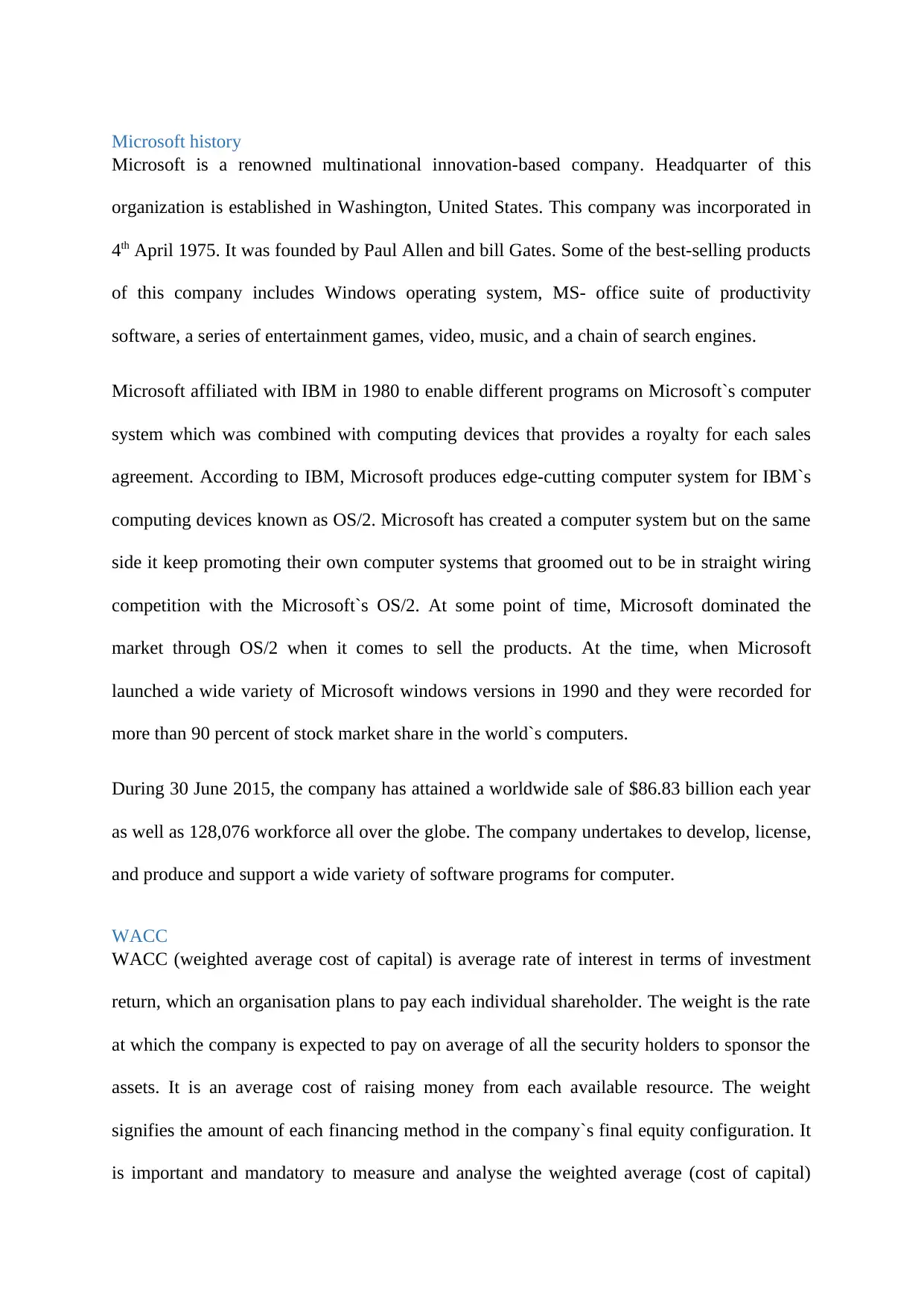
Microsoft history
Microsoft is a renowned multinational innovation-based company. Headquarter of this
organization is established in Washington, United States. This company was incorporated in
4th April 1975. It was founded by Paul Allen and bill Gates. Some of the best-selling products
of this company includes Windows operating system, MS- office suite of productivity
software, a series of entertainment games, video, music, and a chain of search engines.
Microsoft affiliated with IBM in 1980 to enable different programs on Microsoft`s computer
system which was combined with computing devices that provides a royalty for each sales
agreement. According to IBM, Microsoft produces edge-cutting computer system for IBM`s
computing devices known as OS/2. Microsoft has created a computer system but on the same
side it keep promoting their own computer systems that groomed out to be in straight wiring
competition with the Microsoft`s OS/2. At some point of time, Microsoft dominated the
market through OS/2 when it comes to sell the products. At the time, when Microsoft
launched a wide variety of Microsoft windows versions in 1990 and they were recorded for
more than 90 percent of stock market share in the world`s computers.
During 30 June 2015, the company has attained a worldwide sale of $86.83 billion each year
as well as 128,076 workforce all over the globe. The company undertakes to develop, license,
and produce and support a wide variety of software programs for computer.
WACC
WACC (weighted average cost of capital) is average rate of interest in terms of investment
return, which an organisation plans to pay each individual shareholder. The weight is the rate
at which the company is expected to pay on average of all the security holders to sponsor the
assets. It is an average cost of raising money from each available resource. The weight
signifies the amount of each financing method in the company`s final equity configuration. It
is important and mandatory to measure and analyse the weighted average (cost of capital)
Microsoft is a renowned multinational innovation-based company. Headquarter of this
organization is established in Washington, United States. This company was incorporated in
4th April 1975. It was founded by Paul Allen and bill Gates. Some of the best-selling products
of this company includes Windows operating system, MS- office suite of productivity
software, a series of entertainment games, video, music, and a chain of search engines.
Microsoft affiliated with IBM in 1980 to enable different programs on Microsoft`s computer
system which was combined with computing devices that provides a royalty for each sales
agreement. According to IBM, Microsoft produces edge-cutting computer system for IBM`s
computing devices known as OS/2. Microsoft has created a computer system but on the same
side it keep promoting their own computer systems that groomed out to be in straight wiring
competition with the Microsoft`s OS/2. At some point of time, Microsoft dominated the
market through OS/2 when it comes to sell the products. At the time, when Microsoft
launched a wide variety of Microsoft windows versions in 1990 and they were recorded for
more than 90 percent of stock market share in the world`s computers.
During 30 June 2015, the company has attained a worldwide sale of $86.83 billion each year
as well as 128,076 workforce all over the globe. The company undertakes to develop, license,
and produce and support a wide variety of software programs for computer.
WACC
WACC (weighted average cost of capital) is average rate of interest in terms of investment
return, which an organisation plans to pay each individual shareholder. The weight is the rate
at which the company is expected to pay on average of all the security holders to sponsor the
assets. It is an average cost of raising money from each available resource. The weight
signifies the amount of each financing method in the company`s final equity configuration. It
is important and mandatory to measure and analyse the weighted average (cost of capital)
⊘ This is a preview!⊘
Do you want full access?
Subscribe today to unlock all pages.

Trusted by 1+ million students worldwide
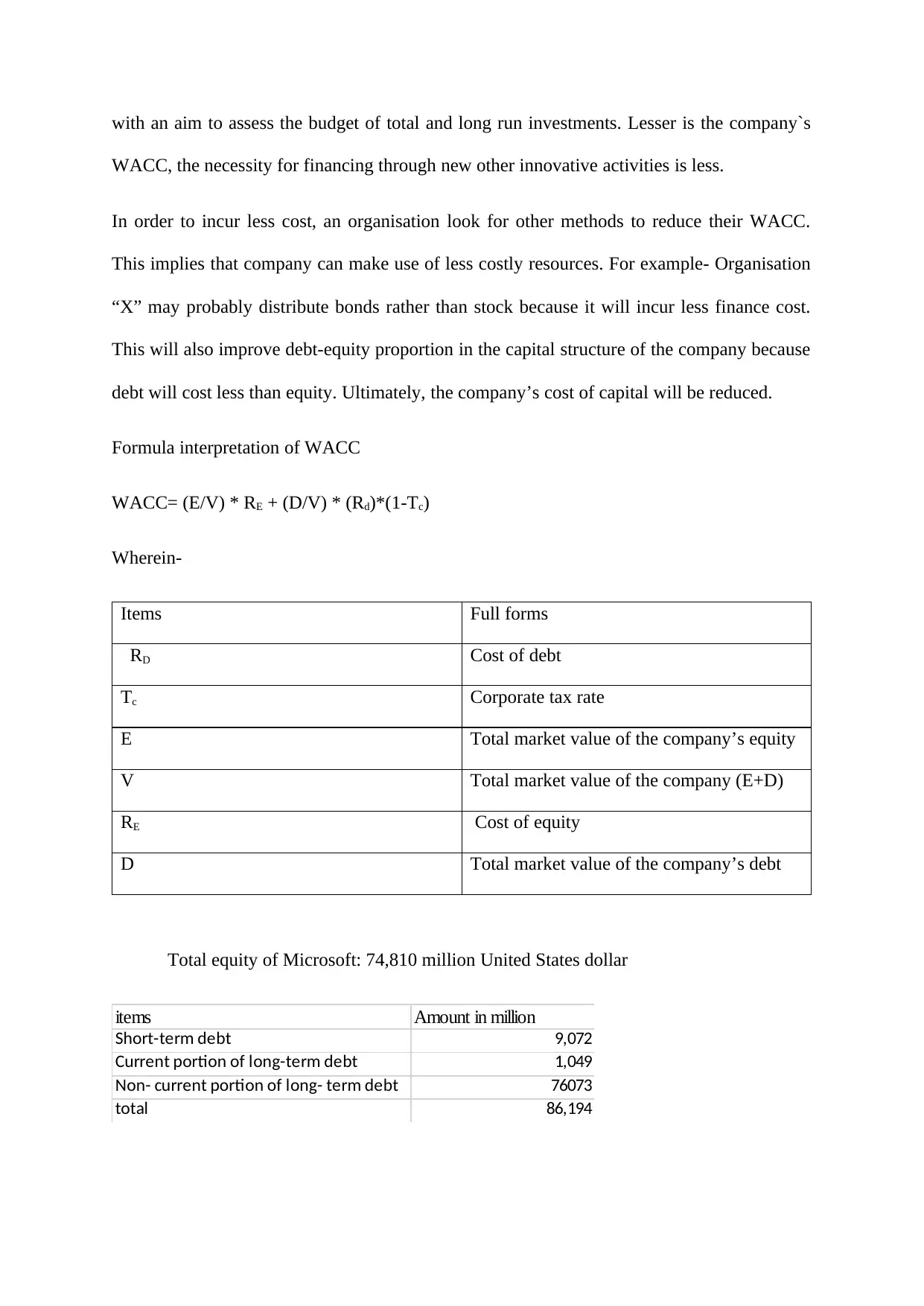
with an aim to assess the budget of total and long run investments. Lesser is the company`s
WACC, the necessity for financing through new other innovative activities is less.
In order to incur less cost, an organisation look for other methods to reduce their WACC.
This implies that company can make use of less costly resources. For example- Organisation
“X” may probably distribute bonds rather than stock because it will incur less finance cost.
This will also improve debt-equity proportion in the capital structure of the company because
debt will cost less than equity. Ultimately, the company’s cost of capital will be reduced.
Formula interpretation of WACC
WACC= (E/V) * RE + (D/V) * (Rd)*(1-Tc)
Wherein-
Items Full forms
RD Cost of debt
Tc Corporate tax rate
E Total market value of the company’s equity
V Total market value of the company (E+D)
RE Cost of equity
D Total market value of the company’s debt
Total equity of Microsoft: 74,810 million United States dollar
items Amount in million
Short-term debt 9,072
Current portion of long-term debt 1,049
Non- current portion of long- term debt 76073
total 86,194
WACC, the necessity for financing through new other innovative activities is less.
In order to incur less cost, an organisation look for other methods to reduce their WACC.
This implies that company can make use of less costly resources. For example- Organisation
“X” may probably distribute bonds rather than stock because it will incur less finance cost.
This will also improve debt-equity proportion in the capital structure of the company because
debt will cost less than equity. Ultimately, the company’s cost of capital will be reduced.
Formula interpretation of WACC
WACC= (E/V) * RE + (D/V) * (Rd)*(1-Tc)
Wherein-
Items Full forms
RD Cost of debt
Tc Corporate tax rate
E Total market value of the company’s equity
V Total market value of the company (E+D)
RE Cost of equity
D Total market value of the company’s debt
Total equity of Microsoft: 74,810 million United States dollar
items Amount in million
Short-term debt 9,072
Current portion of long-term debt 1,049
Non- current portion of long- term debt 76073
total 86,194
Paraphrase This Document
Need a fresh take? Get an instant paraphrase of this document with our AI Paraphraser
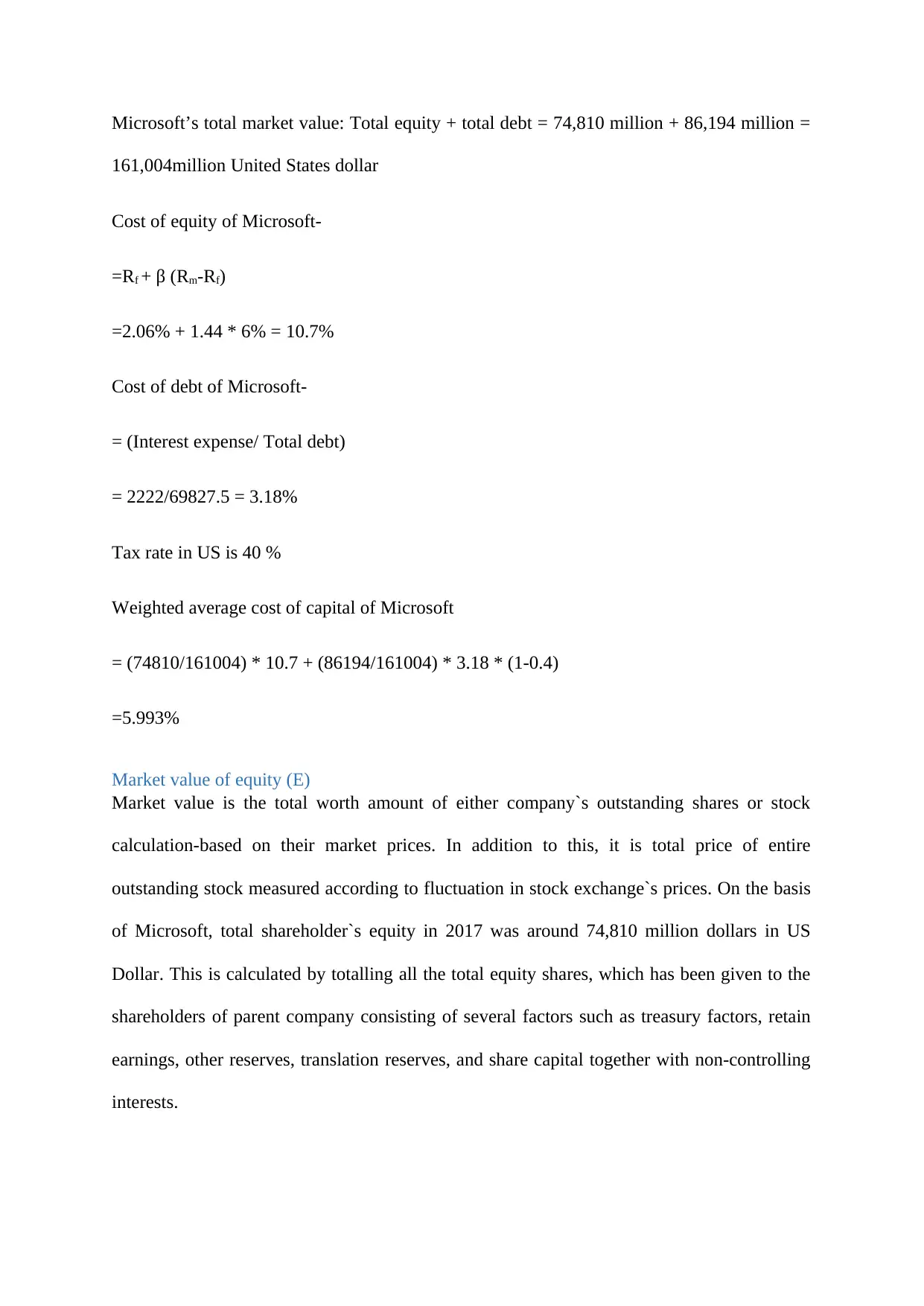
Microsoft’s total market value: Total equity + total debt = 74,810 million + 86,194 million =
161,004million United States dollar
Cost of equity of Microsoft-
=Rf + β (Rm-Rf)
=2.06% + 1.44 * 6% = 10.7%
Cost of debt of Microsoft-
= (Interest expense/ Total debt)
= 2222/69827.5 = 3.18%
Tax rate in US is 40 %
Weighted average cost of capital of Microsoft
= (74810/161004) * 10.7 + (86194/161004) * 3.18 * (1-0.4)
=5.993%
Market value of equity (E)
Market value is the total worth amount of either company`s outstanding shares or stock
calculation-based on their market prices. In addition to this, it is total price of entire
outstanding stock measured according to fluctuation in stock exchange`s prices. On the basis
of Microsoft, total shareholder`s equity in 2017 was around 74,810 million dollars in US
Dollar. This is calculated by totalling all the total equity shares, which has been given to the
shareholders of parent company consisting of several factors such as treasury factors, retain
earnings, other reserves, translation reserves, and share capital together with non-controlling
interests.
161,004million United States dollar
Cost of equity of Microsoft-
=Rf + β (Rm-Rf)
=2.06% + 1.44 * 6% = 10.7%
Cost of debt of Microsoft-
= (Interest expense/ Total debt)
= 2222/69827.5 = 3.18%
Tax rate in US is 40 %
Weighted average cost of capital of Microsoft
= (74810/161004) * 10.7 + (86194/161004) * 3.18 * (1-0.4)
=5.993%
Market value of equity (E)
Market value is the total worth amount of either company`s outstanding shares or stock
calculation-based on their market prices. In addition to this, it is total price of entire
outstanding stock measured according to fluctuation in stock exchange`s prices. On the basis
of Microsoft, total shareholder`s equity in 2017 was around 74,810 million dollars in US
Dollar. This is calculated by totalling all the total equity shares, which has been given to the
shareholders of parent company consisting of several factors such as treasury factors, retain
earnings, other reserves, translation reserves, and share capital together with non-controlling
interests.
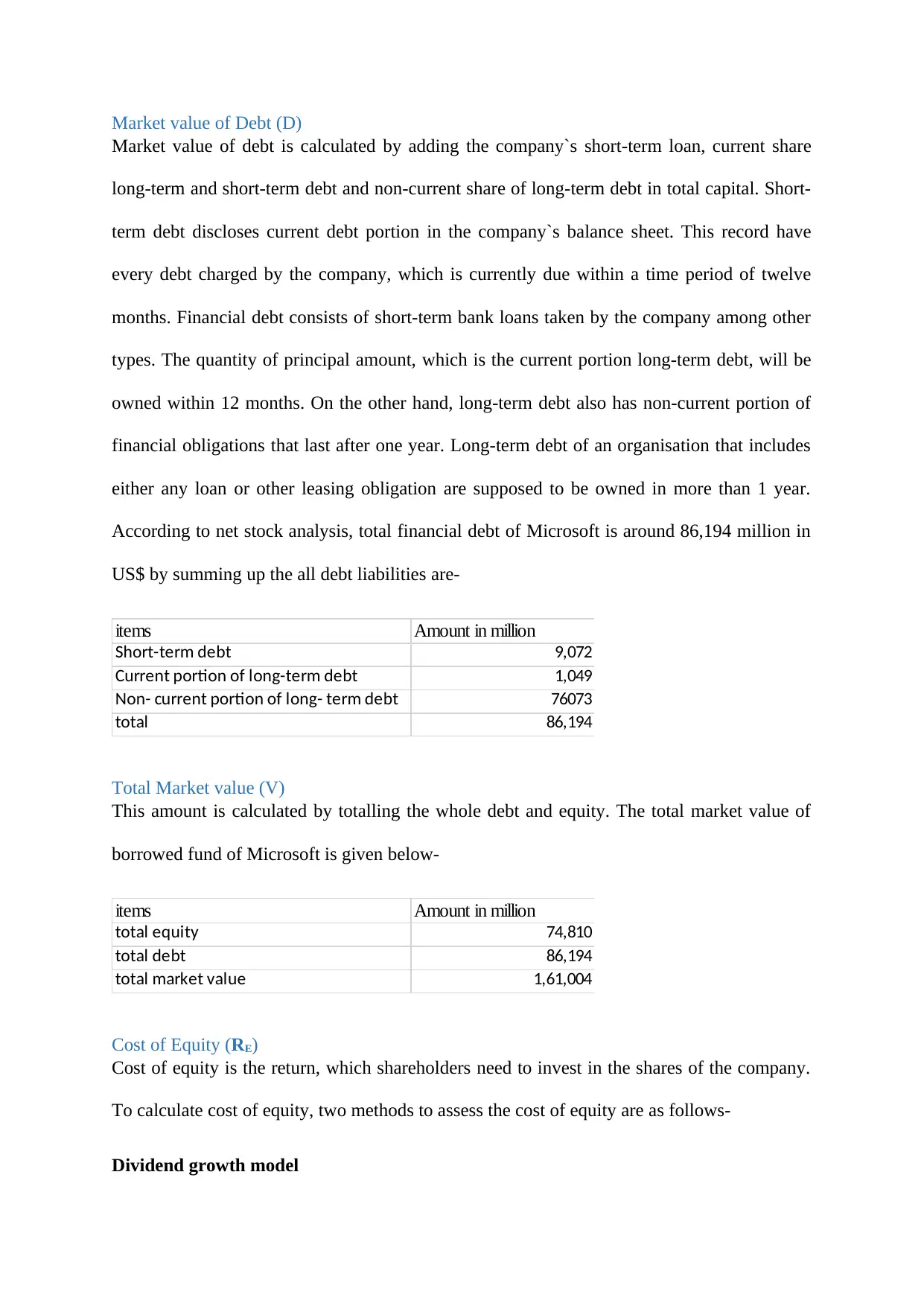
Market value of Debt (D)
Market value of debt is calculated by adding the company`s short-term loan, current share
long-term and short-term debt and non-current share of long-term debt in total capital. Short-
term debt discloses current debt portion in the company`s balance sheet. This record have
every debt charged by the company, which is currently due within a time period of twelve
months. Financial debt consists of short-term bank loans taken by the company among other
types. The quantity of principal amount, which is the current portion long-term debt, will be
owned within 12 months. On the other hand, long-term debt also has non-current portion of
financial obligations that last after one year. Long-term debt of an organisation that includes
either any loan or other leasing obligation are supposed to be owned in more than 1 year.
According to net stock analysis, total financial debt of Microsoft is around 86,194 million in
US$ by summing up the all debt liabilities are-
items Amount in million
Short-term debt 9,072
Current portion of long-term debt 1,049
Non- current portion of long- term debt 76073
total 86,194
Total Market value (V)
This amount is calculated by totalling the whole debt and equity. The total market value of
borrowed fund of Microsoft is given below-
items Amount in million
total equity 74,810
total debt 86,194
total market value 1,61,004
Cost of Equity (RE)
Cost of equity is the return, which shareholders need to invest in the shares of the company.
To calculate cost of equity, two methods to assess the cost of equity are as follows-
Dividend growth model
Market value of debt is calculated by adding the company`s short-term loan, current share
long-term and short-term debt and non-current share of long-term debt in total capital. Short-
term debt discloses current debt portion in the company`s balance sheet. This record have
every debt charged by the company, which is currently due within a time period of twelve
months. Financial debt consists of short-term bank loans taken by the company among other
types. The quantity of principal amount, which is the current portion long-term debt, will be
owned within 12 months. On the other hand, long-term debt also has non-current portion of
financial obligations that last after one year. Long-term debt of an organisation that includes
either any loan or other leasing obligation are supposed to be owned in more than 1 year.
According to net stock analysis, total financial debt of Microsoft is around 86,194 million in
US$ by summing up the all debt liabilities are-
items Amount in million
Short-term debt 9,072
Current portion of long-term debt 1,049
Non- current portion of long- term debt 76073
total 86,194
Total Market value (V)
This amount is calculated by totalling the whole debt and equity. The total market value of
borrowed fund of Microsoft is given below-
items Amount in million
total equity 74,810
total debt 86,194
total market value 1,61,004
Cost of Equity (RE)
Cost of equity is the return, which shareholders need to invest in the shares of the company.
To calculate cost of equity, two methods to assess the cost of equity are as follows-
Dividend growth model
⊘ This is a preview!⊘
Do you want full access?
Subscribe today to unlock all pages.

Trusted by 1+ million students worldwide
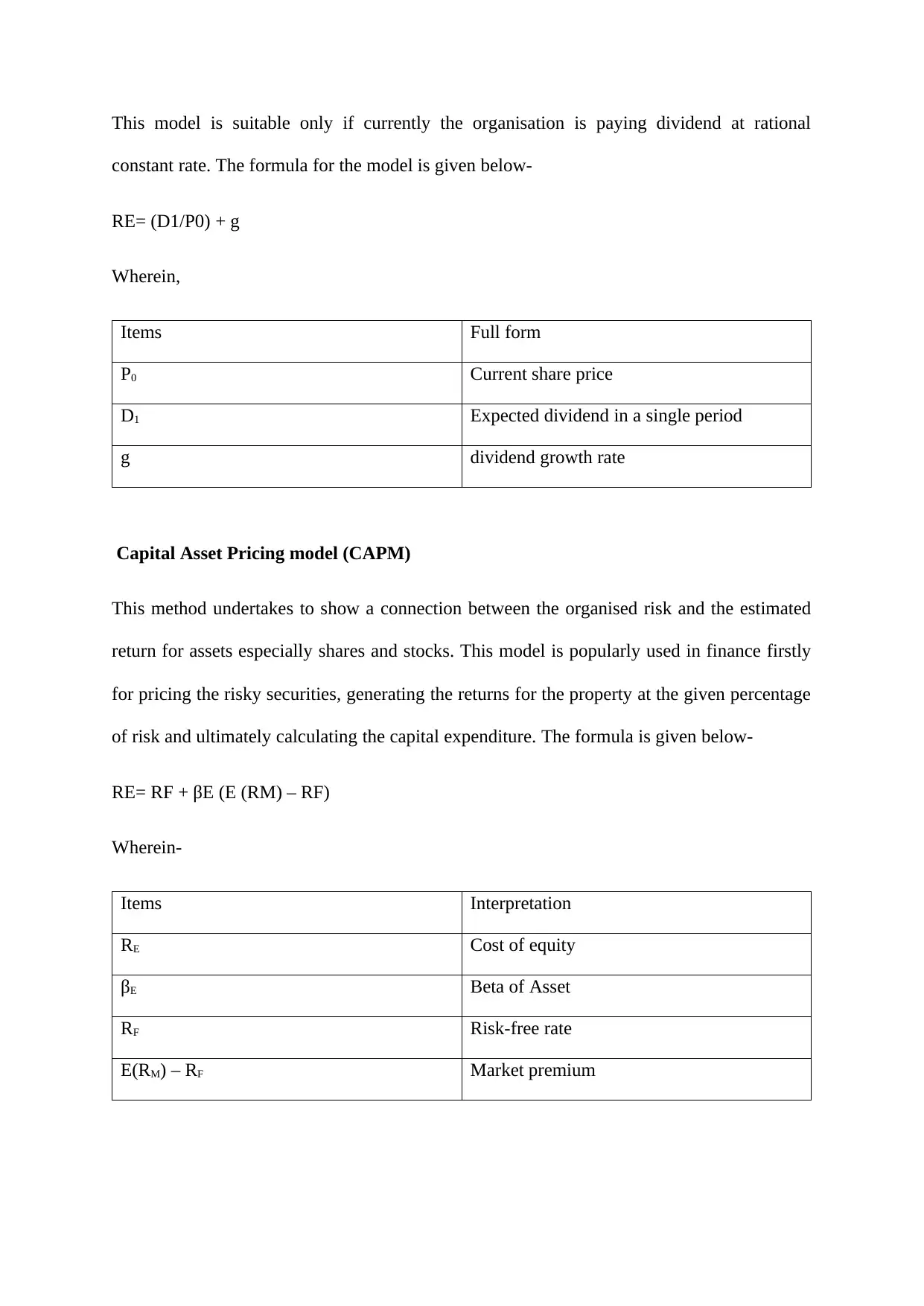
This model is suitable only if currently the organisation is paying dividend at rational
constant rate. The formula for the model is given below-
RE= (D1/P0) + g
Wherein,
Items Full form
P0 Current share price
D1 Expected dividend in a single period
g dividend growth rate
Capital Asset Pricing model (CAPM)
This method undertakes to show a connection between the organised risk and the estimated
return for assets especially shares and stocks. This model is popularly used in finance firstly
for pricing the risky securities, generating the returns for the property at the given percentage
of risk and ultimately calculating the capital expenditure. The formula is given below-
RE= RF + βE (E (RM) – RF)
Wherein-
Items Interpretation
RE Cost of equity
βE Beta of Asset
RF Risk-free rate
E(RM) – RF Market premium
constant rate. The formula for the model is given below-
RE= (D1/P0) + g
Wherein,
Items Full form
P0 Current share price
D1 Expected dividend in a single period
g dividend growth rate
Capital Asset Pricing model (CAPM)
This method undertakes to show a connection between the organised risk and the estimated
return for assets especially shares and stocks. This model is popularly used in finance firstly
for pricing the risky securities, generating the returns for the property at the given percentage
of risk and ultimately calculating the capital expenditure. The formula is given below-
RE= RF + βE (E (RM) – RF)
Wherein-
Items Interpretation
RE Cost of equity
βE Beta of Asset
RF Risk-free rate
E(RM) – RF Market premium
Paraphrase This Document
Need a fresh take? Get an instant paraphrase of this document with our AI Paraphraser
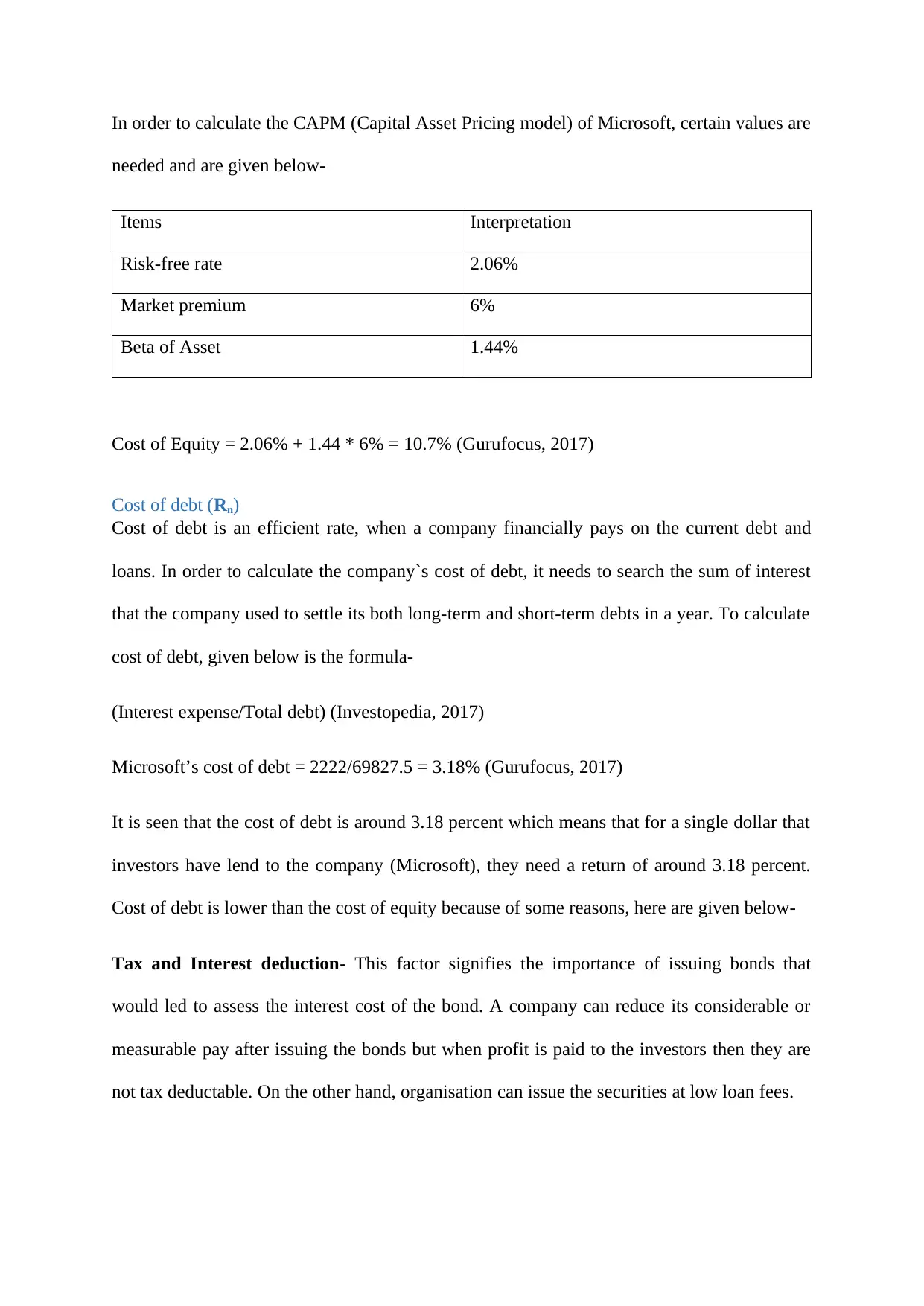
In order to calculate the CAPM (Capital Asset Pricing model) of Microsoft, certain values are
needed and are given below-
Items Interpretation
Risk-free rate 2.06%
Market premium 6%
Beta of Asset 1.44%
Cost of Equity = 2.06% + 1.44 * 6% = 10.7% (Gurufocus, 2017)
Cost of debt (Rn)
Cost of debt is an efficient rate, when a company financially pays on the current debt and
loans. In order to calculate the company`s cost of debt, it needs to search the sum of interest
that the company used to settle its both long-term and short-term debts in a year. To calculate
cost of debt, given below is the formula-
(Interest expense/Total debt) (Investopedia, 2017)
Microsoft’s cost of debt = 2222/69827.5 = 3.18% (Gurufocus, 2017)
It is seen that the cost of debt is around 3.18 percent which means that for a single dollar that
investors have lend to the company (Microsoft), they need a return of around 3.18 percent.
Cost of debt is lower than the cost of equity because of some reasons, here are given below-
Tax and Interest deduction- This factor signifies the importance of issuing bonds that
would led to assess the interest cost of the bond. A company can reduce its considerable or
measurable pay after issuing the bonds but when profit is paid to the investors then they are
not tax deductable. On the other hand, organisation can issue the securities at low loan fees.
needed and are given below-
Items Interpretation
Risk-free rate 2.06%
Market premium 6%
Beta of Asset 1.44%
Cost of Equity = 2.06% + 1.44 * 6% = 10.7% (Gurufocus, 2017)
Cost of debt (Rn)
Cost of debt is an efficient rate, when a company financially pays on the current debt and
loans. In order to calculate the company`s cost of debt, it needs to search the sum of interest
that the company used to settle its both long-term and short-term debts in a year. To calculate
cost of debt, given below is the formula-
(Interest expense/Total debt) (Investopedia, 2017)
Microsoft’s cost of debt = 2222/69827.5 = 3.18% (Gurufocus, 2017)
It is seen that the cost of debt is around 3.18 percent which means that for a single dollar that
investors have lend to the company (Microsoft), they need a return of around 3.18 percent.
Cost of debt is lower than the cost of equity because of some reasons, here are given below-
Tax and Interest deduction- This factor signifies the importance of issuing bonds that
would led to assess the interest cost of the bond. A company can reduce its considerable or
measurable pay after issuing the bonds but when profit is paid to the investors then they are
not tax deductable. On the other hand, organisation can issue the securities at low loan fees.
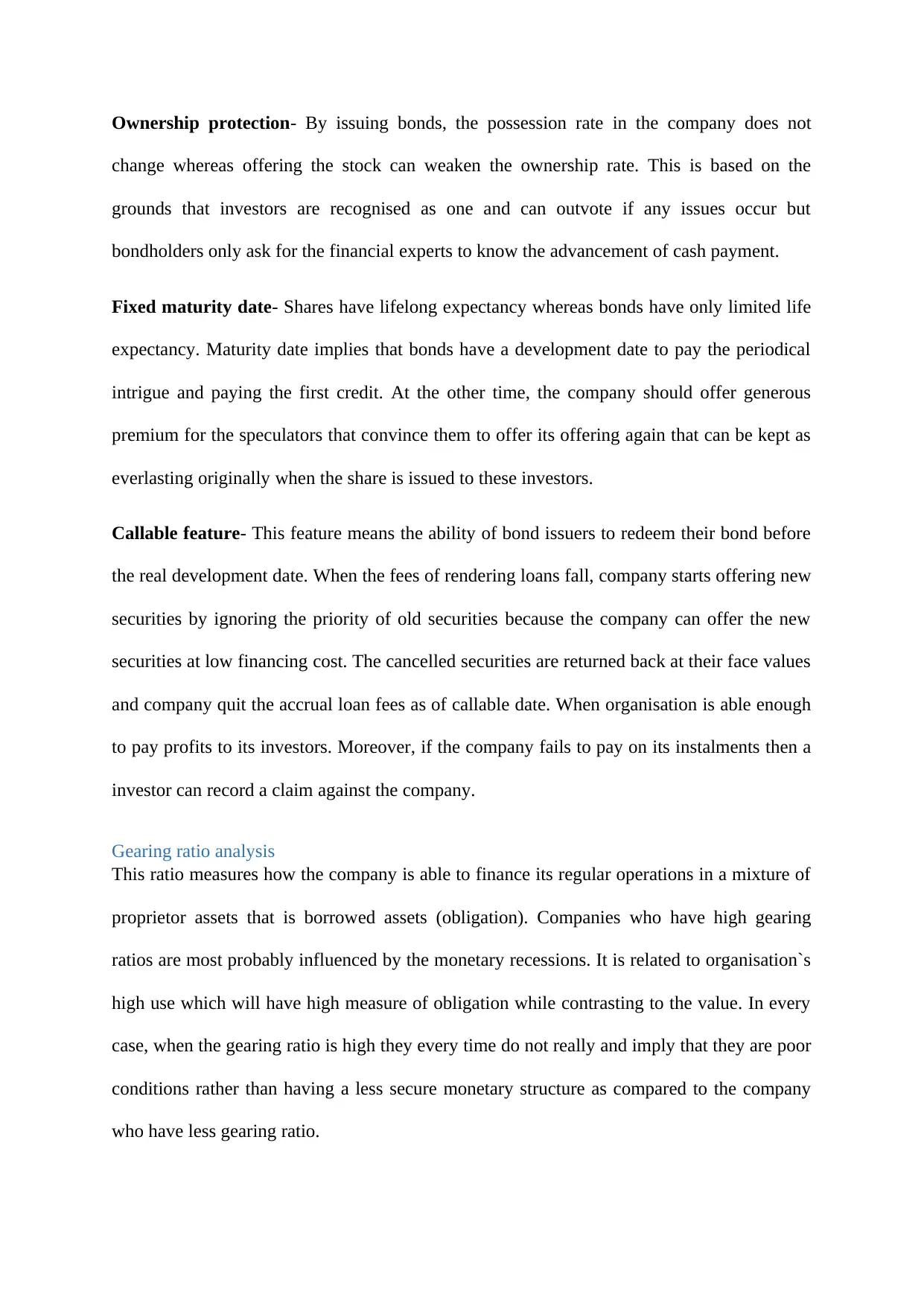
Ownership protection- By issuing bonds, the possession rate in the company does not
change whereas offering the stock can weaken the ownership rate. This is based on the
grounds that investors are recognised as one and can outvote if any issues occur but
bondholders only ask for the financial experts to know the advancement of cash payment.
Fixed maturity date- Shares have lifelong expectancy whereas bonds have only limited life
expectancy. Maturity date implies that bonds have a development date to pay the periodical
intrigue and paying the first credit. At the other time, the company should offer generous
premium for the speculators that convince them to offer its offering again that can be kept as
everlasting originally when the share is issued to these investors.
Callable feature- This feature means the ability of bond issuers to redeem their bond before
the real development date. When the fees of rendering loans fall, company starts offering new
securities by ignoring the priority of old securities because the company can offer the new
securities at low financing cost. The cancelled securities are returned back at their face values
and company quit the accrual loan fees as of callable date. When organisation is able enough
to pay profits to its investors. Moreover, if the company fails to pay on its instalments then a
investor can record a claim against the company.
Gearing ratio analysis
This ratio measures how the company is able to finance its regular operations in a mixture of
proprietor assets that is borrowed assets (obligation). Companies who have high gearing
ratios are most probably influenced by the monetary recessions. It is related to organisation`s
high use which will have high measure of obligation while contrasting to the value. In every
case, when the gearing ratio is high they every time do not really and imply that they are poor
conditions rather than having a less secure monetary structure as compared to the company
who have less gearing ratio.
change whereas offering the stock can weaken the ownership rate. This is based on the
grounds that investors are recognised as one and can outvote if any issues occur but
bondholders only ask for the financial experts to know the advancement of cash payment.
Fixed maturity date- Shares have lifelong expectancy whereas bonds have only limited life
expectancy. Maturity date implies that bonds have a development date to pay the periodical
intrigue and paying the first credit. At the other time, the company should offer generous
premium for the speculators that convince them to offer its offering again that can be kept as
everlasting originally when the share is issued to these investors.
Callable feature- This feature means the ability of bond issuers to redeem their bond before
the real development date. When the fees of rendering loans fall, company starts offering new
securities by ignoring the priority of old securities because the company can offer the new
securities at low financing cost. The cancelled securities are returned back at their face values
and company quit the accrual loan fees as of callable date. When organisation is able enough
to pay profits to its investors. Moreover, if the company fails to pay on its instalments then a
investor can record a claim against the company.
Gearing ratio analysis
This ratio measures how the company is able to finance its regular operations in a mixture of
proprietor assets that is borrowed assets (obligation). Companies who have high gearing
ratios are most probably influenced by the monetary recessions. It is related to organisation`s
high use which will have high measure of obligation while contrasting to the value. In every
case, when the gearing ratio is high they every time do not really and imply that they are poor
conditions rather than having a less secure monetary structure as compared to the company
who have less gearing ratio.
⊘ This is a preview!⊘
Do you want full access?
Subscribe today to unlock all pages.

Trusted by 1+ million students worldwide
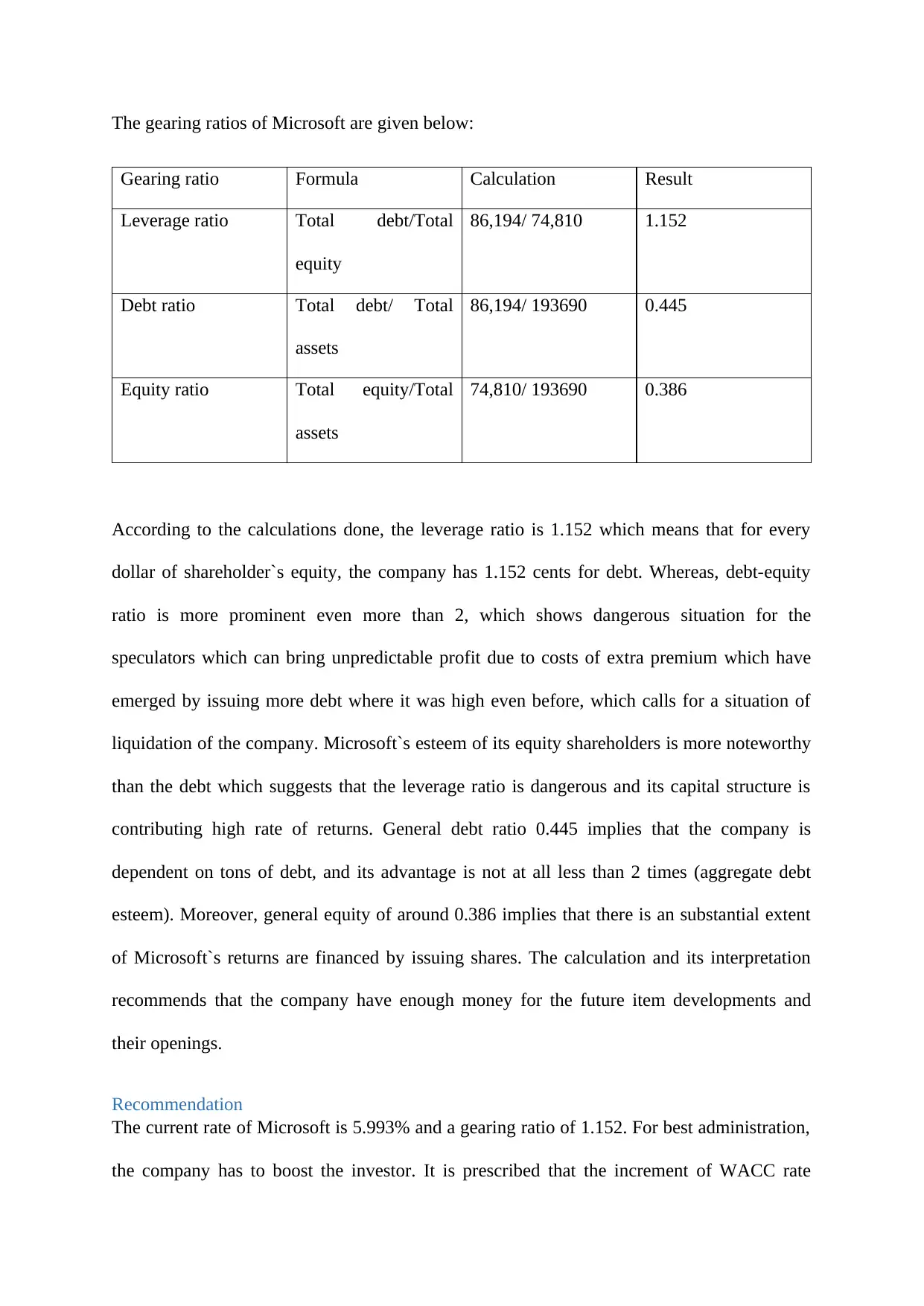
The gearing ratios of Microsoft are given below:
Gearing ratio Formula Calculation Result
Leverage ratio Total debt/Total
equity
86,194/ 74,810 1.152
Debt ratio Total debt/ Total
assets
86,194/ 193690 0.445
Equity ratio Total equity/Total
assets
74,810/ 193690 0.386
According to the calculations done, the leverage ratio is 1.152 which means that for every
dollar of shareholder`s equity, the company has 1.152 cents for debt. Whereas, debt-equity
ratio is more prominent even more than 2, which shows dangerous situation for the
speculators which can bring unpredictable profit due to costs of extra premium which have
emerged by issuing more debt where it was high even before, which calls for a situation of
liquidation of the company. Microsoft`s esteem of its equity shareholders is more noteworthy
than the debt which suggests that the leverage ratio is dangerous and its capital structure is
contributing high rate of returns. General debt ratio 0.445 implies that the company is
dependent on tons of debt, and its advantage is not at all less than 2 times (aggregate debt
esteem). Moreover, general equity of around 0.386 implies that there is an substantial extent
of Microsoft`s returns are financed by issuing shares. The calculation and its interpretation
recommends that the company have enough money for the future item developments and
their openings.
Recommendation
The current rate of Microsoft is 5.993% and a gearing ratio of 1.152. For best administration,
the company has to boost the investor. It is prescribed that the increment of WACC rate
Gearing ratio Formula Calculation Result
Leverage ratio Total debt/Total
equity
86,194/ 74,810 1.152
Debt ratio Total debt/ Total
assets
86,194/ 193690 0.445
Equity ratio Total equity/Total
assets
74,810/ 193690 0.386
According to the calculations done, the leverage ratio is 1.152 which means that for every
dollar of shareholder`s equity, the company has 1.152 cents for debt. Whereas, debt-equity
ratio is more prominent even more than 2, which shows dangerous situation for the
speculators which can bring unpredictable profit due to costs of extra premium which have
emerged by issuing more debt where it was high even before, which calls for a situation of
liquidation of the company. Microsoft`s esteem of its equity shareholders is more noteworthy
than the debt which suggests that the leverage ratio is dangerous and its capital structure is
contributing high rate of returns. General debt ratio 0.445 implies that the company is
dependent on tons of debt, and its advantage is not at all less than 2 times (aggregate debt
esteem). Moreover, general equity of around 0.386 implies that there is an substantial extent
of Microsoft`s returns are financed by issuing shares. The calculation and its interpretation
recommends that the company have enough money for the future item developments and
their openings.
Recommendation
The current rate of Microsoft is 5.993% and a gearing ratio of 1.152. For best administration,
the company has to boost the investor. It is prescribed that the increment of WACC rate
Paraphrase This Document
Need a fresh take? Get an instant paraphrase of this document with our AI Paraphraser
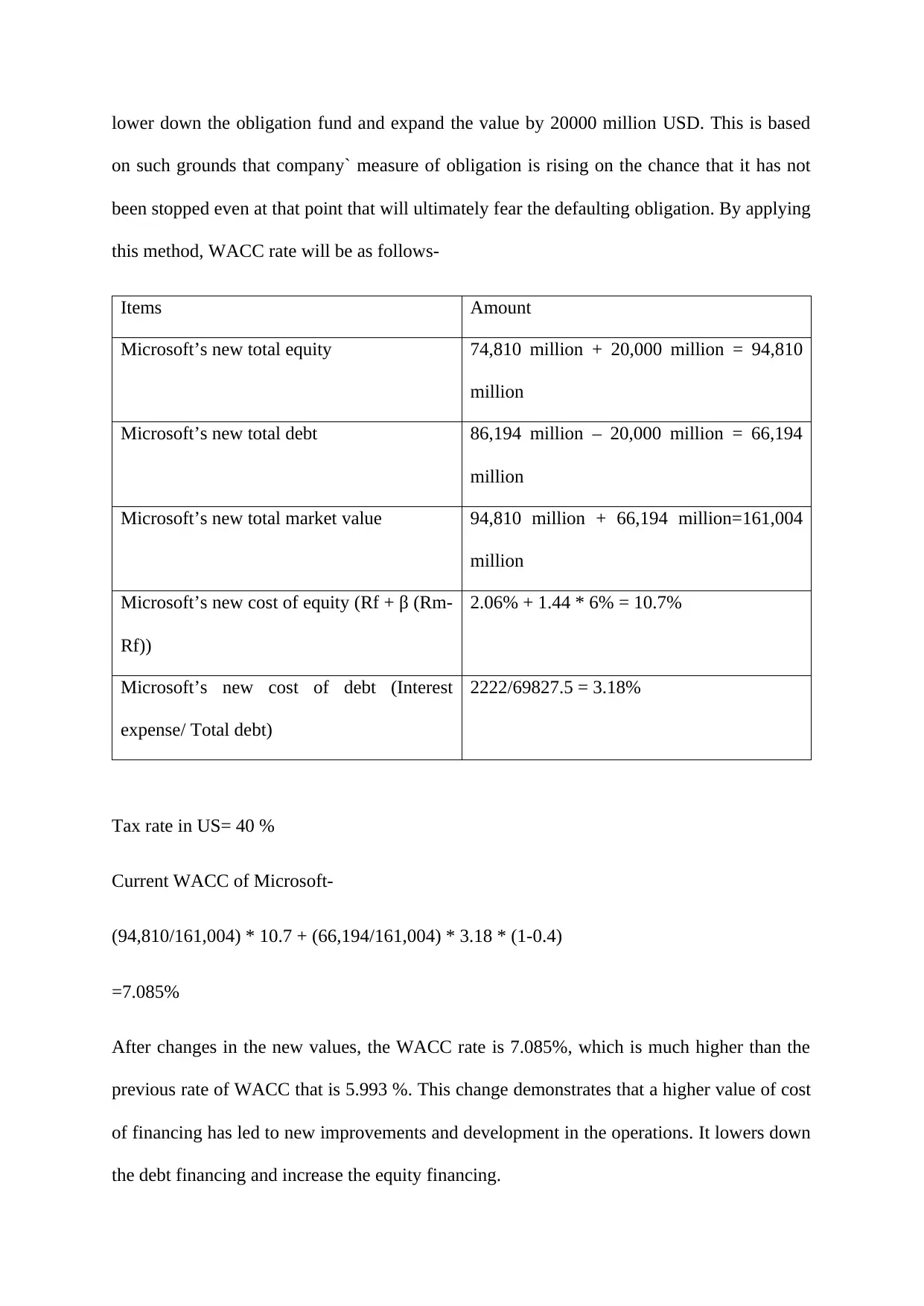
lower down the obligation fund and expand the value by 20000 million USD. This is based
on such grounds that company` measure of obligation is rising on the chance that it has not
been stopped even at that point that will ultimately fear the defaulting obligation. By applying
this method, WACC rate will be as follows-
Items Amount
Microsoft’s new total equity 74,810 million + 20,000 million = 94,810
million
Microsoft’s new total debt 86,194 million – 20,000 million = 66,194
million
Microsoft’s new total market value 94,810 million + 66,194 million=161,004
million
Microsoft’s new cost of equity (Rf + β (Rm-
Rf))
2.06% + 1.44 * 6% = 10.7%
Microsoft’s new cost of debt (Interest
expense/ Total debt)
2222/69827.5 = 3.18%
Tax rate in US= 40 %
Current WACC of Microsoft-
(94,810/161,004) * 10.7 + (66,194/161,004) * 3.18 * (1-0.4)
=7.085%
After changes in the new values, the WACC rate is 7.085%, which is much higher than the
previous rate of WACC that is 5.993 %. This change demonstrates that a higher value of cost
of financing has led to new improvements and development in the operations. It lowers down
the debt financing and increase the equity financing.
on such grounds that company` measure of obligation is rising on the chance that it has not
been stopped even at that point that will ultimately fear the defaulting obligation. By applying
this method, WACC rate will be as follows-
Items Amount
Microsoft’s new total equity 74,810 million + 20,000 million = 94,810
million
Microsoft’s new total debt 86,194 million – 20,000 million = 66,194
million
Microsoft’s new total market value 94,810 million + 66,194 million=161,004
million
Microsoft’s new cost of equity (Rf + β (Rm-
Rf))
2.06% + 1.44 * 6% = 10.7%
Microsoft’s new cost of debt (Interest
expense/ Total debt)
2222/69827.5 = 3.18%
Tax rate in US= 40 %
Current WACC of Microsoft-
(94,810/161,004) * 10.7 + (66,194/161,004) * 3.18 * (1-0.4)
=7.085%
After changes in the new values, the WACC rate is 7.085%, which is much higher than the
previous rate of WACC that is 5.993 %. This change demonstrates that a higher value of cost
of financing has led to new improvements and development in the operations. It lowers down
the debt financing and increase the equity financing.
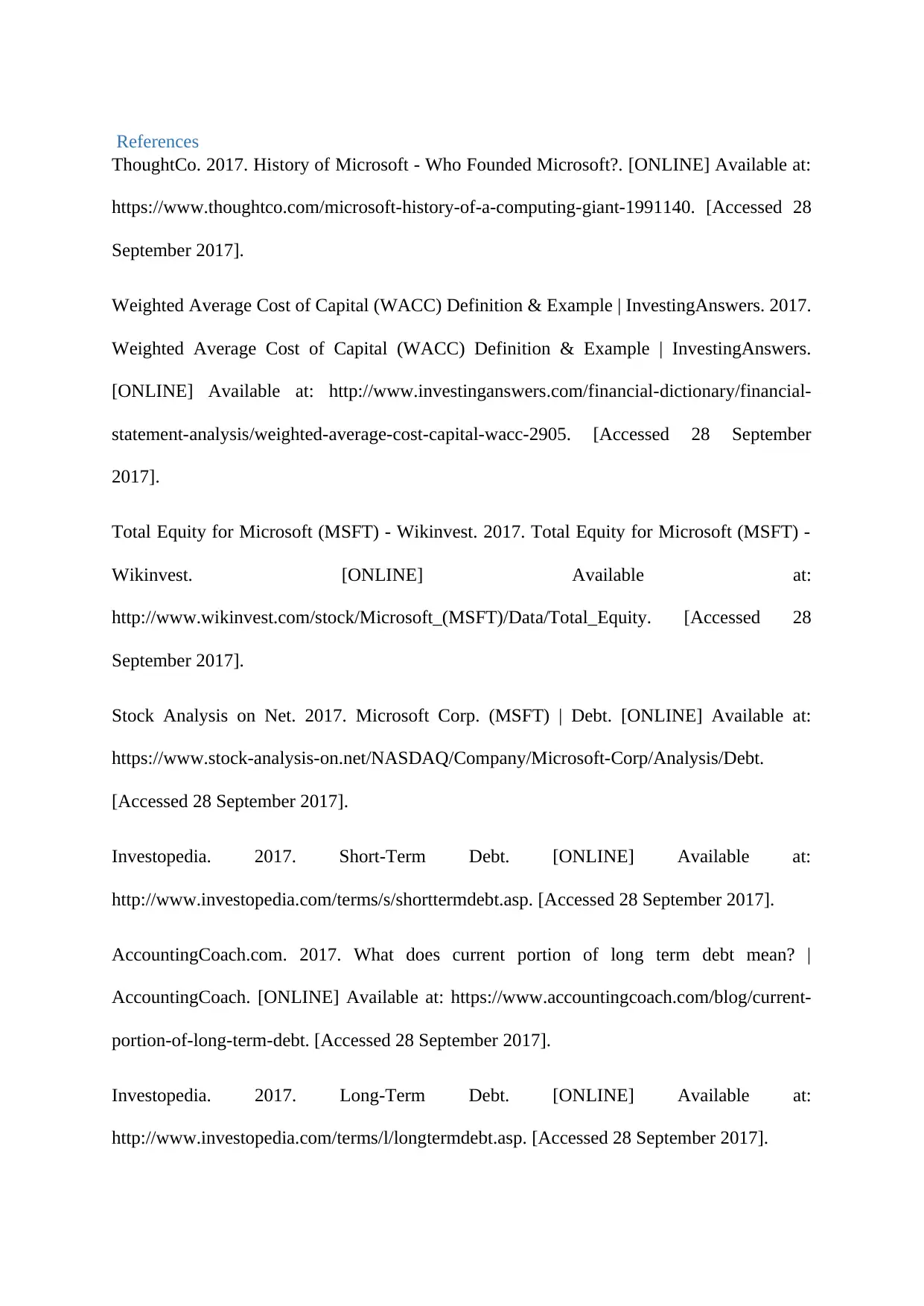
References
ThoughtCo. 2017. History of Microsoft - Who Founded Microsoft?. [ONLINE] Available at:
https://www.thoughtco.com/microsoft-history-of-a-computing-giant-1991140. [Accessed 28
September 2017].
Weighted Average Cost of Capital (WACC) Definition & Example | InvestingAnswers. 2017.
Weighted Average Cost of Capital (WACC) Definition & Example | InvestingAnswers.
[ONLINE] Available at: http://www.investinganswers.com/financial-dictionary/financial-
statement-analysis/weighted-average-cost-capital-wacc-2905. [Accessed 28 September
2017].
Total Equity for Microsoft (MSFT) - Wikinvest. 2017. Total Equity for Microsoft (MSFT) -
Wikinvest. [ONLINE] Available at:
http://www.wikinvest.com/stock/Microsoft_(MSFT)/Data/Total_Equity. [Accessed 28
September 2017].
Stock Analysis on Net. 2017. Microsoft Corp. (MSFT) | Debt. [ONLINE] Available at:
https://www.stock-analysis-on.net/NASDAQ/Company/Microsoft-Corp/Analysis/Debt.
[Accessed 28 September 2017].
Investopedia. 2017. Short-Term Debt. [ONLINE] Available at:
http://www.investopedia.com/terms/s/shorttermdebt.asp. [Accessed 28 September 2017].
AccountingCoach.com. 2017. What does current portion of long term debt mean? |
AccountingCoach. [ONLINE] Available at: https://www.accountingcoach.com/blog/current-
portion-of-long-term-debt. [Accessed 28 September 2017].
Investopedia. 2017. Long-Term Debt. [ONLINE] Available at:
http://www.investopedia.com/terms/l/longtermdebt.asp. [Accessed 28 September 2017].
ThoughtCo. 2017. History of Microsoft - Who Founded Microsoft?. [ONLINE] Available at:
https://www.thoughtco.com/microsoft-history-of-a-computing-giant-1991140. [Accessed 28
September 2017].
Weighted Average Cost of Capital (WACC) Definition & Example | InvestingAnswers. 2017.
Weighted Average Cost of Capital (WACC) Definition & Example | InvestingAnswers.
[ONLINE] Available at: http://www.investinganswers.com/financial-dictionary/financial-
statement-analysis/weighted-average-cost-capital-wacc-2905. [Accessed 28 September
2017].
Total Equity for Microsoft (MSFT) - Wikinvest. 2017. Total Equity for Microsoft (MSFT) -
Wikinvest. [ONLINE] Available at:
http://www.wikinvest.com/stock/Microsoft_(MSFT)/Data/Total_Equity. [Accessed 28
September 2017].
Stock Analysis on Net. 2017. Microsoft Corp. (MSFT) | Debt. [ONLINE] Available at:
https://www.stock-analysis-on.net/NASDAQ/Company/Microsoft-Corp/Analysis/Debt.
[Accessed 28 September 2017].
Investopedia. 2017. Short-Term Debt. [ONLINE] Available at:
http://www.investopedia.com/terms/s/shorttermdebt.asp. [Accessed 28 September 2017].
AccountingCoach.com. 2017. What does current portion of long term debt mean? |
AccountingCoach. [ONLINE] Available at: https://www.accountingcoach.com/blog/current-
portion-of-long-term-debt. [Accessed 28 September 2017].
Investopedia. 2017. Long-Term Debt. [ONLINE] Available at:
http://www.investopedia.com/terms/l/longtermdebt.asp. [Accessed 28 September 2017].
⊘ This is a preview!⊘
Do you want full access?
Subscribe today to unlock all pages.

Trusted by 1+ million students worldwide
1 out of 14
Related Documents
Your All-in-One AI-Powered Toolkit for Academic Success.
+13062052269
info@desklib.com
Available 24*7 on WhatsApp / Email
![[object Object]](/_next/static/media/star-bottom.7253800d.svg)
Unlock your academic potential
Copyright © 2020–2025 A2Z Services. All Rights Reserved. Developed and managed by ZUCOL.





